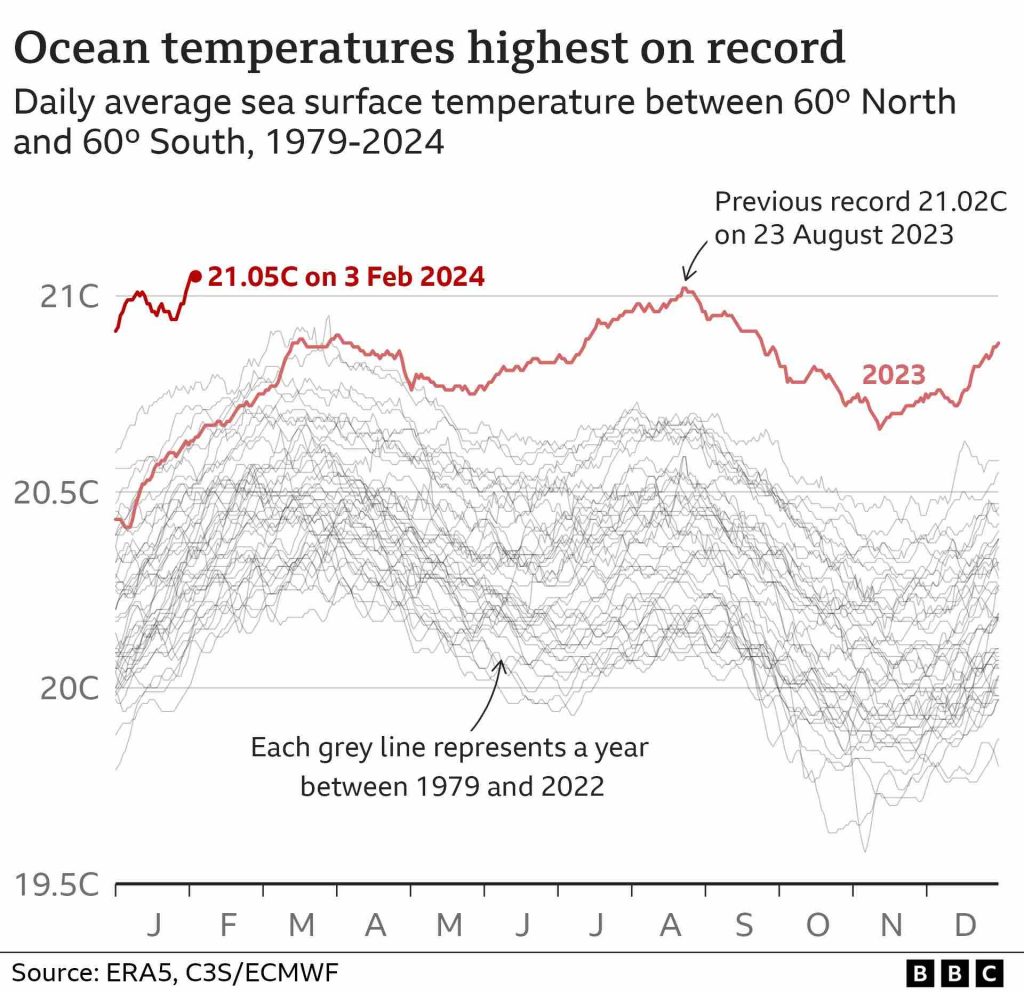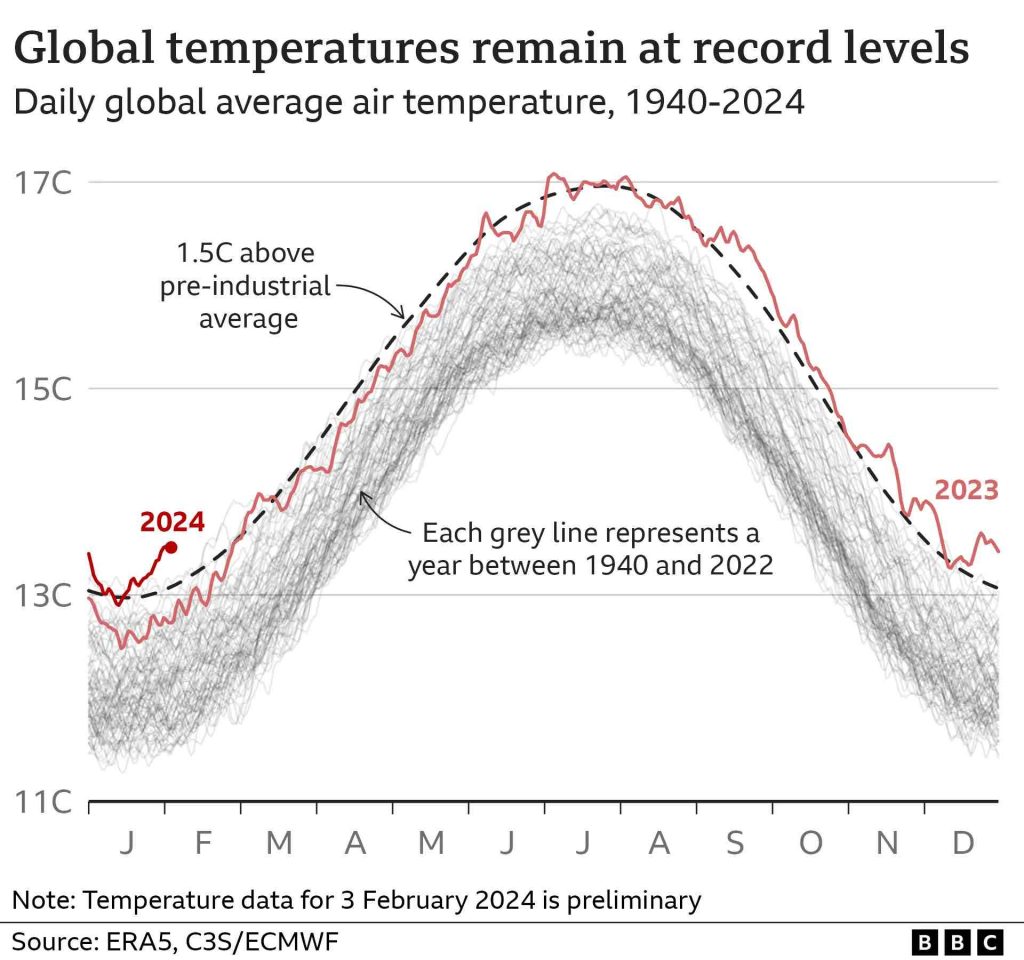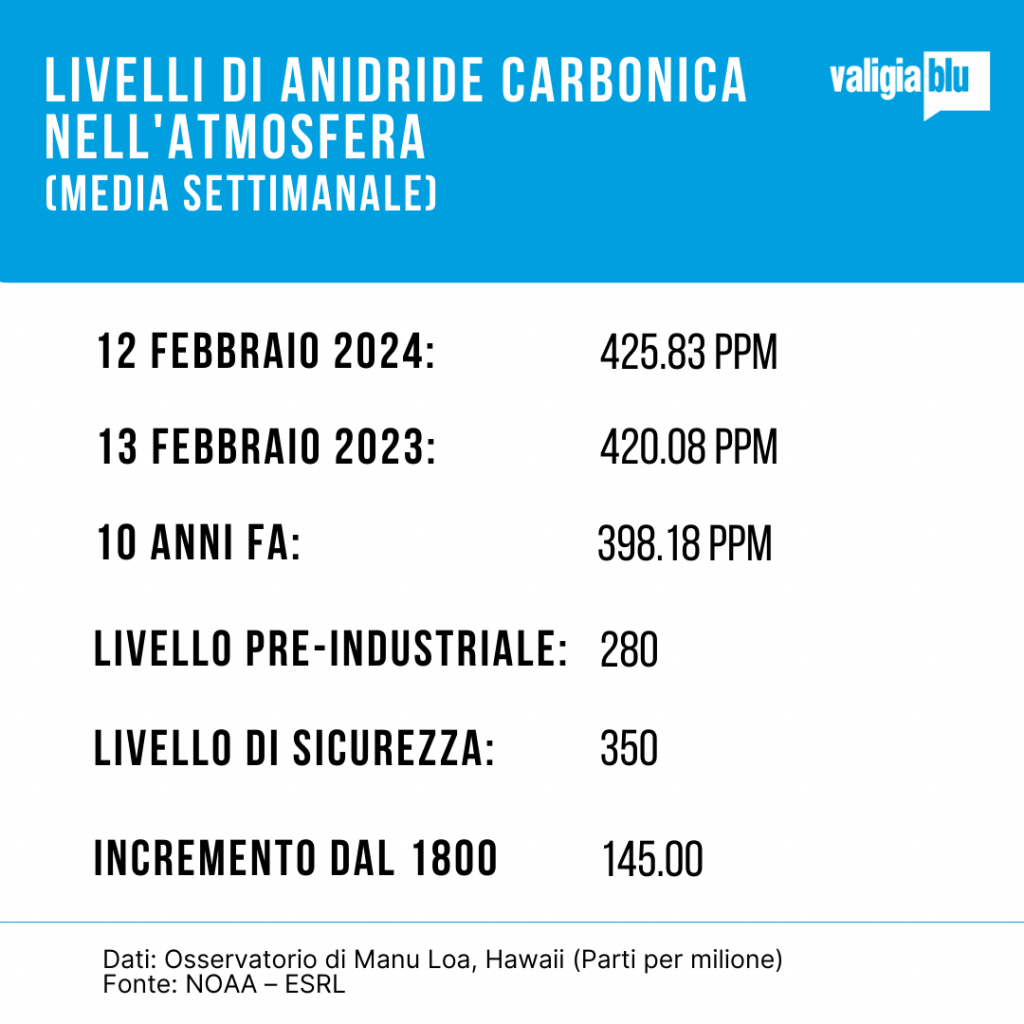https://www.valigiablu.it/amazzonia-crisi-climatica-riscaldamento-globale/
- |
The weekly round-up on the climate crisis and data on carbon dioxide levels in the atmosphere.
According to new research published on February 14th on Nature, nearly half of the Amazon will face several “unprecedented” stressors that could push the forest toward a major tipping point by 2050.The largest rainforest in the world he's already under pressure due to climate change, deforestation, biodiversity loss and extreme weather conditions.
About 20% of the Amazon it has already been deforested and another 6% are “highly degraded.” According to several studies, the Brazilian section of the Amazon is now a net “source” of carbon, rather than a “sink,” due to a number of factors including deforestation.
The scholars have long warned that climate change and human-driven deforestation could push the Amazon forest beyond the “tipping point,” a threshold that, if exceeded, would see the “disappearance” of large amounts of dense Amazon forest and the transition to a permanent, dry savanna.The latter would feature a mixed system of trees and pastures with open cover that allows the soil to become much warmer and drier.
Previous studies they suggest that the Amazon could be pushed beyond this tipping point if forest loss exceeds 40%.Another research published last October he noted that the recent drying of the Amazon could be the “early warning sign” that the rainforest is approaching a tipping point, rebuilds an in-depth look at the British site Carbon Brief.
Now the new study published on Nature.The researchers examined five key drivers of water stress in the Amazon – global warming, annual rainfall, the intensity of rainfall seasonality, the length of the dry season and accumulated deforestation – and found how the combination of different disturbances – such as l 'intensification of drought and fires - could trigger "unexpected ecosystem transitions even in remote and central areas" of the Amazon and therefore transform vast areas of rainforest into dry savannas.
“It's surprising how the combination of stressors and disturbances is already affecting parts of the central Amazon...[which] can already transform into different ecosystems.(...) Then, when you put it all together, the possibility that by 2050 we could pass this tipping point, a large-scale tipping point, is very scary and I really didn't think it could happen so soon,” he said. commented a Carbon Brief Dr. Bernardo Flores, lead author of the study and researcher at the Federal University of Santa Catarina, Brazil.
The study findings highlight that approximately half (47%) of the Amazon biome has moderate potential for these changes.The largest and most remote areas, covering 53% of the Amazon, have a low possibility of ecosystem transition, especially regarding protected areas and indigenous territories.The top 10% have “relatively high transition potential,” meaning they are already experiencing more than two types of disruption.
The research "highlights the urgency of keeping both global warming and deforestation within safe limits" to protect the Amazon, Prof. also comments to Carbon Brief.Dominick Spracklen, professor of biosphere-atmosphere interactions at the University of Leeds.However, Flores adds that stopping deforestation without intervening on greenhouse gas emissions could prove "useless".
The rate of deforestation in the Brazilian Amazon has soared under former President Jair Bolsonaro, but has almost halved in 2023 since The Lula government took office.Meanwhile, forest loss in Bolivian sections of the Amazon reached record levels in 2022.
According to Spracklen, this disparity “highlights the need for a pan-Amazon alliance to help collaboratively reduce deforestation.”
Plus, in this week's climate round-up:
For the first time, global warming exceeded the 1.5°C threshold for an entire year
The European Union weather service, Copernicus, he announced that in the 12 months between February 2023 and January 2024, the average temperature of the planet exceeded the ceiling of 1.5°C compared to pre-industrial levels for the first time for an entire year.Not exceeding one and a half degrees from pre-industrial levels is the threshold that states around the world set themselves with the 2015 Paris Agreement.In the last twelve months, the temperature has been 1.52°C higher than the average for the period 1850-1900.
It was something in the forecast and that doesn't question him objectives set with the Paris Agreement in 2015. Last May, a study by the World Meteorological Organization (WMO) concluded that in the next five years the Earth would experience new temperature records and global warming would probably exceed 1.5°C compared to pre-industrial levels.Urgent action to reduce carbon emissions can still slow warming, scientists say.
The world's sea surface also reached its highest average temperature ever recorded, as shown in this graph:

Anthropic activity undoubtedly contributed to bringing temperatures steadily above 1.5°C, starting above all from the combustion of fossil fuels, which releases gases that warm the planet such as carbon dioxide.Added to this was the activity of El Niño, a cyclical phenomenon that causes the surface of the central-eastern Pacific Ocean to warm and contributes to pushing up the planet's temperatures.
El Niño is, in fact, the warm phase of a natural fluctuation of the Earth's climate system (whose full name is El Niño-Southern Oscillation, or ENSO) which normally lasts a couple of years and which adds to the long-term trend of man-made global warming.El Niño causes year-to-year fluctuations by moving heat in and out of deeper ocean layers.Global surface temperatures tend to be colder during La Niña years and warmer during El Niño years.
Global average air temperatures began to exceed 1.5°C of warming on a near-daily basis in the second half of 2023, when El Niño began to take effect, and continued into 2024 (as indicated by the points where the red line exceeds the dotted line in the graph below).

It is expected that when the El Niño action stops, global temperatures will temporarily stabilize and then drop slightly, probably back below the 1.5°C threshold.But if human activities continue to increase levels of warming gases in the atmosphere, temperatures will continue to rise in the coming decades.
At the current rate of emissions, the Paris target of limiting global warming to 1.5°C from pre-industrial levels as a long-term average - rather than a single year - could be exceeded within the next decade. According to IPC reportsC, exceeding that threshold could have potentially irreversible disastrous consequences for the planet.Such as, for example, the irreversible collapse of the West Antarctic ice sheet which could be triggered once the warming of marine waters causes its retreat into the deep underwater basin in which it is located, leading in turn to a rise of up to 3 meters of sea level.Which could trigger other knock-on effects, further global warming by amplifying greenhouse gas emissions from natural sources, explains in an article about The Conversation David Armstrong McKay, researcher in Earth Resilience Systems at Stockholm University.However, McKay adds, most scientists do not expect the world to reach a series of climate turning points if it temporarily exceeds 1.5°C.
There will be stronger effects when El Niño already impacts average global temperatures 1.5°C higher than the pre-industrial era.In that case, “a future strong El Niño that temporarily pushes global average temperatures to 1.7°C could cause some coral reefs to begin dying before a cooling La Niña arrives,” McKay further explains.“For other systems that respond more slowly to warming, such as ice sheets, the next La Niña should (temporarily) balance things out.”
We still have space and time to intervene.With the increase in green technologies and based on current policies and commitments, some scenarios, such as a rise in global temperatures of 4°C or more within this century - thought possible just a decade ago - are now considered much less likely.
And, perhaps most encouragingly, climate scientists believe the planet may stop warming once it reaches net zero carbon emissions.Effectively halving emissions this decade is seen as particularly crucial.
“This means we can control how much the world warms, based on our choices as a society and as a planet,” says Zeke Hausfather, a climate scientist at the US group Berkeley Earth.“Catastrophe is not inevitable.”
Clean energy, melting glaciers and carbon capture:Iceland is already experiencing our future
“Iceland is already living in our future” is the title of the reportage by journalist David Gelles on New York Times.Iceland, Gelles writes, offers a window into our collective future in at least three aspects:clean energy, melting glaciers and carbon capture.
The country uses very few fossil fuels to power its economy and heat its homes.85% of Icelandic energy comes from domestically produced renewable sources, especially geothermal and hydroelectric.Its territory is, in fact, located on top of an active volcanic area and six large geothermal plants exploit the heat from the subsoil to provide heating to almost all the houses in the country.Geothermal energy, continues Geddes, produces around 20% of Iceland's electricity, the rest comes from the network of hydroelectric power plants, while oil is mainly used to power cars, trucks and fishing boats.
However, although not a major emitter, Iceland is seeing its landscape and economy profoundly transformed by the effects of climate change.
Although Iceland is not a major producer of planet-warming emissions, the effects of climate change are already transforming its landscape and economy.One of its glaciers, Okjokull, it completely melted.Over the next 200 years, scientists predict that others, including the huge Vatnajokull glacier, could also disappear.Some research suggests that the melting of large glaciers could trigger greater volcanic and seismic activity.Underground tremors are already damaging pipes in some cities and triggering, Sometimes, sudden floods.
The warmer climate also affects plants and animals.The native plants of Iceland they are at risk of extinction due to rising temperatures and the arrival of invasive species.One of the most important fish in the country, the capelin, has periodically disappeared due to warming of the waters.And like all coastal cities around the world, Iceland's capital, Reykjavik, is threatened by rising sea levels.
Among the technologies being tested is the controversial carbon capture and storage.A local company, Carbfix, will take care of the capture of carbon dioxide and its sequestration underground.A Swiss company, Climeworks, has built its two largest plants for extraction directly from the air in Iceland.
Parisians have voted to triple the cost of parking for SUVs
In a referendum held last February 4, the inhabitants of Paris they voted to triple the cost of parking for SUVs.54.6% voted in favor.However, turnout - around 5.7% of registered voters in Paris - was lower than supporters of the referendum campaign had hoped.
“Parisians have made a clear choice...other cities will follow,” commented the mayor, Anne Hidalgo, adding that road safety and air pollution were the main reasons for the vote.Previously, Hidalgo had described the proposal to limit the presence of SUVs by increasing parking prices as "a form of social justice":the aim was to target wealthier drivers of expensive, heavy and polluting cars who have not yet changed their behavior to address the climate crisis.The referendum arrived, in fact, while the city is committed to reducing emissions and air pollution.
Under the Hidalgo administration, Paris has increased pressure on motorists by increasing parking costs, gradually banning diesel vehicles while expanding its network of cycle lanes.The city has reduced the number of on-street parking spaces to push drivers to use underground parking.The city said bicycle use increased 71% from the end of pandemic lockdowns to 2023.
The deputy mayor of Paris with responsibility for transport, David Belliard, of the Green party, said that around 10% of vehicles in Paris will be affected by the increase in parking charges, which could earn the city up to 35 million euros per year. 'year.
Motoring pressure group '40 Millions d'Automobilistes' has argued that motorists should be free to choose the vehicle they want, warning that the move to increase parking charges is unjustified and the work of "an ultra-urban minority and anti-car".
Portugal, the Cascais challenge:achieve carbon neutrality through technologies and individual behaviors
Cascais, a well-known tourist destination in Portugal, is one of the most innovative cities in Europe to fight climate change.Through the experimentation of technological innovations, sustainable management of resources and the involvement of citizens, is trying to become the first Portuguese city with net zero emissions by 2050.And, at the same time, a point of reference for innovation and sustainable development in the fight against climate change.
Action suits are different.First of all, sustainable mobility.The Municipality created MobiCascais, a platform that integrates different transport service operators and a network of infrastructure and equipment.The objective is to offer a diversified and flexible set of mobility solutions and services that meet the needs of inhabitants, workers and tourists and encourage the use of public transport and soft mobility solutions.
Another area of intervention is land consumption.Through the Oxigénio project, Cascais is trying to defend nature and biodiversity.The project aims to involve the community in nature conservation actions.
Finally, the Municipality is intervening on the reduction of waste production and recycling.The waste management system combines the use of underground containers with remote fill level sensor technology.While underground containers reduce visual impact and maximize the use of urban space, remote fill level sensors installed in these containers allow smart collection to be activated and managed when they are almost full.Sensors read the level of waste in each container and transmit the data to a central management platform that determines when and how collection vehicles should begin their journey.This management platform is accessible remotely with any web browser.Installing underground waste containers and equipping them with remote fill level sensors has helped reduce the costs of municipal waste services in Cascais while improving services.
Climate denialism:Climate scientist Michael Mann wins $1 million defamation lawsuit
The US climate scientist, Michael Mann, won a defamation case of $1 million against Rand Simberg and Mark Steyn who in two separate articles had called his analyzes on global warming fraudulent and compared his research activity to a coach's molestation of minors.
“Today's verdict restores Mike Mann's good reputation.It is also a great victory for the truth and for scientists around the world who dedicate their lives to answering vital scientific questions that impact human health and the planet,” one of the climate scientist's lawyers commented on X.
Our statement: pic.twitter.com/7dVQDXnwyI
—Prof Michael E.Mann (@MichaelEMann) February 8, 2024
The case dates back to 12 years ago.In 2009 some climate deniers began to argue that Mann, who became known for the famous "hockey stick" graph to represent the trend of global warming, published for the first time in 1998 on Nature, had manipulated the data in his research.However, investigations by Penn State University and an analysis of emails byAssociated Press, had not detected any misuse of data by Mann. In the introduction of this ebook we reconstructed the whole story.
Despite this, in 2012, the Competitive Enterprise Institute, a libertarian thinktank, published a post by Rand Simberg that compared Penn State University's investigation into Mann's work to the case of Jerry Sandusky, a former assistant football coach convicted of sexually assaulting several children.“You could say Mann is the Jerry Sandusky of climate science, only instead of molesting children, he molested and tortured data,” Simberg wrote.Next, in another article about NationalReview, Mark Steyn had called Mann's research "fraudulent", echoing Simberg's post.
Mann sued the two authors of the articles and their publishers.And now, 12 years later, here is the sentence condemning Simberg and Steyn to pay one thousand and one million dollars respectively.
“I hope this verdict sends an unmistakable message that falsely attacking climate scientists is not without consequences,” Mann said.
Data on carbon dioxide levels in the atmosphere

Preview image:BBC video frames via YouTube
